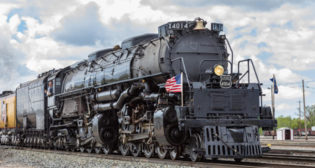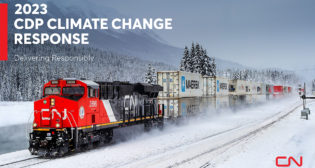
INRD, Cummins roll out QSK95 freight locomotive
Written by William C. Vantuono, Editor-in-Chief
After two years of development and testing, Indiana Rail Road (INRD) SD90-43MAC no. 1919, the first heavy-haul freight locomotive equipped with a Cummins 16-cylinder, 4,400-hp, Tier 4-compliant QSK95 high-speed diesel power plant, is operating as a “mobile laboratory,” according to INRD Senior Vice President Operations and Business Development Bob Babcock.
1919 is a joint venture of INRD, Cummins, TMV Control Systems, which supplied the microprocessor control system, and Brookville Equipment, which handled the engine installation and performed system integration. At 4,400 hp (3,281 kW), the QSK95 “achieves the highest output of any 16-cylinder high-speed (1,800 rpm) diesel,” Cummins said. “Combining our latest-generation Modular Common Rail Fuel System (MCRS) with quad-turbocharging, the QSK95 delivers reduced noise, excellent response and ultra-low-emissions capability.”
 INRD’s repowered SD90-43MAC is a prototype six-axle, heavy-haul Tier 4 freight locomotive. The 95-litre QSK95, developed as part of Cummins’ $1.35 billion “Hedgehog” engine program, is modular in design, the 16-cylinder version of a line that also includes V-12 and V-20 versions starting at 3,200 hp. Bore and stroke are 190 mm X 210 mm. Dry weight is 15.17 tons. The engine is rated at up to 12,838 foot-pounds of torque. Turbochargers are four HE900s. Engine cooling is achieved through a two-pump, two-loop system with LTA (load temperature aftercooling) radiators. EPA Tier 4 compliance is achieved through in-cylinder combustion technology and urea-based SCR (Selective Catalytic Reduction). The urea is known as DEF (diesel exhaust fluid). It’s injected directly into the exhaust stream, catalyzing a chemical reaction whose end products are nitrogen and oxygen, normal atmospheric elements. Fuel injectors are high-atomization Bosch units.
INRD’s repowered SD90-43MAC is a prototype six-axle, heavy-haul Tier 4 freight locomotive. The 95-litre QSK95, developed as part of Cummins’ $1.35 billion “Hedgehog” engine program, is modular in design, the 16-cylinder version of a line that also includes V-12 and V-20 versions starting at 3,200 hp. Bore and stroke are 190 mm X 210 mm. Dry weight is 15.17 tons. The engine is rated at up to 12,838 foot-pounds of torque. Turbochargers are four HE900s. Engine cooling is achieved through a two-pump, two-loop system with LTA (load temperature aftercooling) radiators. EPA Tier 4 compliance is achieved through in-cylinder combustion technology and urea-based SCR (Selective Catalytic Reduction). The urea is known as DEF (diesel exhaust fluid). It’s injected directly into the exhaust stream, catalyzing a chemical reaction whose end products are nitrogen and oxygen, normal atmospheric elements. Fuel injectors are high-atomization Bosch units.
Compared to modern medium-speed (900 rpm) diesels, the QSK95 is more than 30% lighter, offers 42% lower heat rejection, 44% lower oil consumption, and up to 7% lower fuel consumption. Compared to older Tier 0 engines, NOx emissions are 89% lower, HC (hydrocarbons) are 97% lower, PM (particulate matter) is 98% lower, and fuel consumption is 16% lower.
“We are running 1919 through its paces,” Babcock explained. “We’re operating it with 17,000-ton coal trains, intermodal trains, and in yard switching service. It’s got lots of power and is very versatile.” He noted the “ease of working with the Cummins technical staff.”
QSK95 ductile cast iron engine blocks are cast in Germany by Gienanth GmbH. Rough machining takes place at the Cummins Daventry (U.K.) Engine Plant. Final machining and assembly occurs at the Cummins Seymour (Indiana) Engine Plant. The engines are produced currently at a rate of one per day.
The QSK95 is also the power plant for the Siemens Charger higher-speed, 125-mph diesel-electric locomotives that are being built for a five-state HrSR (higher-speed rail) initiative encompassing the departments of transportation of Illinois, California, Michigan, Missouri and Washington. Charger locomotives will also power the trainsets for All Aboard Florida’s soon-to-debut Brightline passenger service. Maryland’s MARC recently ordered eight Chargers.
Brightline’s first Charger successfully completed initial testing iand operated for the first time on the quarter-mile test track at the Siemens manufacturing facility in Sacramento, Calif., in early September.
“This signifies another major milestone for the production of Brightline’s trains as the company has now approved production for all locomotives currently being built by Siemens,” said Brightline Senior Vice President of Railroad Operations Gene Skoropowski.
In addition to firing up its diesel engine for the first time, approximately 45 systems were tested on the locomotive. Among them: functional tests of the air and dynamic braking systems; software installation for all systems; locomotive doors; fire detection systems; audible warning devices; communication systems; interior and exterior lighting; and zero-fuel and fully fueled weight verification. Static and dynamic testing occurred over a three-week period.
“Operation of the locomotive and its passing of initial track testing has demonstrated Siemens’ engineering expertise and given us a high degree of confidence that Brightline service will be exceptionally reliable,” said Skoropowski. “Brightline will be the only passenger rail service in the country to have such dynamic and modern trains that will offer Americans a new and modern experience in train travel.”
“Testing these advanced-technology locomotives for Brightline is an extremely important milestone in our production process and helps ensure these trainsets are ready to provide safe and reliable service for future riders,” said Siemens Rolling Stock President Michael Cahill. “The successful on-site testing in Sacramento is truly a testament to the highly skilled work being done by our engineers and plant employees that have worked tirelessly to design and manufacture these trainsets.”
Brightline’s trains are built as integrated trainsets, comprised of two locomotives and four stainless steel passenger cars. The locomotives feature an ergonomic cab design for the train’s engineers.
Brightline trainsets are being built by nearly 1,000 employees at Siemens’ 60-acre rail manufacturing hub. Siemens has also developed a base of U.S. rail suppliers to support the next-generation of rail manufacturing for Brightline, including components from more than 40 suppliers across 20-plus states. The company will also be providing maintenance for the trainsets when they are in operation in Florida, supporting full-time employment for approximately 70 Siemens and 40 Brightline employees.
The first completed trainset is expected to leave Sacramento and be delivered to Brightline at its West Palm Beach maintenance facility later this year. Brightline is scheduled to begin express higher-speed intercity service linking Miami, Fort Lauderdale and West Palm Beach on the Florida East Coast Railway main line in mid-2017. Brightline says it is “the only privately owned, operated and maintained passenger rail system in the United States.” It is operated by All Aboard Florida, a subsidiary of Florida East Coast Industries.



